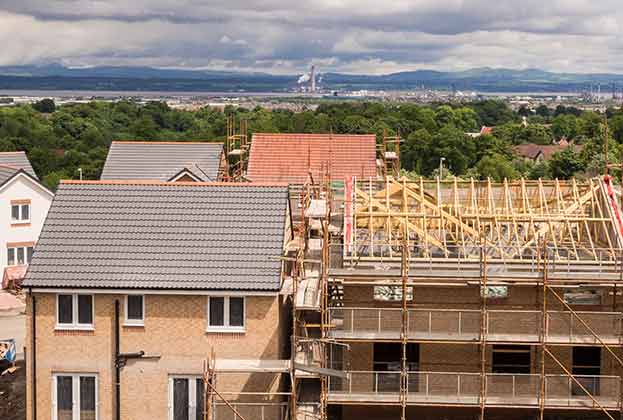How well are local plans in England responding to climate change?
Across England, there is little correlation between local authorities declaring a climate emergency and implementing climate mitigation and adaptation measures in their local plans. The Climate Change Committee declared in a 2020 report that “Most local plans do not acknowledge the extent of the challenge of delivering net zero and need significant revision“. Most recently, the UK Green Building Council co-ordinated a letter from business leaders to the Prime Minister, warning that the current planning system could not meet the pace of change needed to meet sustainability targets.
Of areas that have announced a climate emergency, 71% have an up to date local plan in place. But only 19% of these local plans contain specific energy efficiency or binding carbon policies. Encouragingly however, more recently adopted plans are the most likely to contain these types of policy. 50% of plans adopted in 2020 contain specific carbon emission reduction policies, compared to just 13% of those adopted in 2015.
So how soon could the remainder of the country begin to adopt policies that are pro-active in their approach to carbon emission reductions? A third of English local authorities without specific carbon reduction policies in place still have not adopted a local plan since the publication of the 2012 NPPF. Based on the current progress of local plans in these areas, we expect 70% will be adopted by 2023.
The remaining local authorities have all adopted NPPF-compliant plans, with the strategic policies in plans requiring a review every five years. Just under half of these local authorities are currently reviewing their plans, with adoption dates expected throughout 2022 and 2023. Once these reviews are complete, if local authorities meet the commitments made in their climate emergency declarations, we should see climate resilience policies in local plans reach over 50% coverage by 2024.
What tools are available?
The planning system can use spatial and regulatory levers to create policy that contributes to addressing the problem of climate change. In terms of the spatial component of policy, our previous research found that planning permissions were not being delivered in the most sustainable locations or in ways that encouraged active travel or use of public transport (see Planning for Sustainable Development). A further aspect of a spatial approach to climate change is the co-location of different uses, for example, to facilitate heat from one land use being beneficially used for another use through a shared heating system.
Beyond the spatial element, one of the primary mechanisms to tackle emissions available to local authorities are Building Regulations. Part L of Building Regulations, first focusing on energy-efficiency in 1995 and most recently updated in 2013, seeks to control the use of fuel and power through reducing heat loss through key areas of any given building, including the building fabric itself as well as any pipes or ducts within the building. In addition, the regulations recommend building fabric that meets high energy-efficiency standards as well as passive control measures within buildings to encourage continued cooling outside of mechanical assistance.
Local authorities currently have the ability to set higher energy-efficiency standards than the existing Part L requirements or stipulate a minimum BREEAM rating
Emily Williams, Associate Director, Residential Research
Local authorities currently have the ability to set higher energy-efficiency standards than the existing Part L requirements or stipulate a minimum BREEAM rating. In total, 67 local authorities in England have policies for residential development in their most recently adopted local plans that do this, accounting for 21% of local authorities across the country. However, this leaves 79% of local authorities, with housing need totalling 216,000 homes per year, not requiring any additional measures beyond existing Part L regulations.
These policies are more frequently found in urban areas, including Manchester, Oxford, Cambridge, Reading, Portsmouth and multiple London boroughs. These commitments will though be harder to deliver in some locations than others. Local authorities can instead specify carbon offsetting requirements, including making payments to an independent provider, or payment to a national CO2 abatement fund by means of an agreed cost per tonne of carbon. However, where policies require zero carbon, rather than net zero carbon, offsetting technically is not permitted.
Having reviewed current environmental policies in adopted local plans, where a carbon pricing figure is specified, many local authorities have used £60 per tonne of carbon emitted over a 30-year period as a baseline for offsetting. But there is flexibility in the application of this figure as schemes must still remain viable. Milton Keynes Council has simply specified that a contribution must be made to the Council’s carbon offset fund. In higher value areas, a higher level of pricing is possible; in Bristol and in the London Plan financial contributions are set at £95 per tonne over 30 years, although London Boroughs can set their own requirements beyond this baseline. This flexibility is a positive in terms of not placing undue burdens on developers, but will lead to a reduced contribution to carbon offsetting in lower-value areas where viability may already be marginal.
The potential trade-offs
This highlights a key tension in delivering climate mitigation measures; balancing environmental requirements which add to build costs with the need to deliver enough homes to meet housing need. Our survey of English local plans shows that the average percentage of affordable housing required for major residential schemes is 24%. The local authorities with carbon reduction policies in place tend to be broadly in line with this affordable housing figure, but there are some examples of policies that require both a high level of affordable housing and more demanding standards above Building Regulations.
Harborough and Harrogate both have set an affordable housing requirement of 40%, and encourage new developments to reach high environmental standards including passive design measures and renewable energy technology. Richmondshire requires 30% affordable housing while also asking for all new housing developments to incorporate on-site renewable energy. The recently adopted South Oxfordshire local plan requires new development to reach a 50% reduction against 2013 emission baselines from 2026, and for all schemes to be zero carbon from 2030, while also requiring 40–50% affordable housing. This level of policy aspiration in a combination of policy areas increases the risk to project viability and as a consequence, deliverability.
Want to find out more about Planning and Development? Read our latest insights here.
Read the articles within Planning Research 2021 below.
.jpg)


